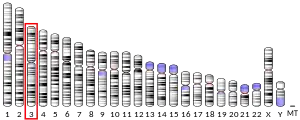SLC7A14
Solute carrier family 7, member 14 is a protein that in humans is encoded by the SLC7A14 gene. [5]
| SLC7A14 | |||||||||||||||||||||||||||||||||||||||||||||||||||
|---|---|---|---|---|---|---|---|---|---|---|---|---|---|---|---|---|---|---|---|---|---|---|---|---|---|---|---|---|---|---|---|---|---|---|---|---|---|---|---|---|---|---|---|---|---|---|---|---|---|---|---|
| Identifiers | |||||||||||||||||||||||||||||||||||||||||||||||||||
| Aliases | SLC7A14, PPP1R142, solute carrier family 7 member 14 | ||||||||||||||||||||||||||||||||||||||||||||||||||
| External IDs | OMIM: 615720 MGI: 3040688 HomoloGene: 76320 GeneCards: SLC7A14 | ||||||||||||||||||||||||||||||||||||||||||||||||||
| |||||||||||||||||||||||||||||||||||||||||||||||||||
| |||||||||||||||||||||||||||||||||||||||||||||||||||
| |||||||||||||||||||||||||||||||||||||||||||||||||||
| |||||||||||||||||||||||||||||||||||||||||||||||||||
| |||||||||||||||||||||||||||||||||||||||||||||||||||
| Wikidata | |||||||||||||||||||||||||||||||||||||||||||||||||||
| |||||||||||||||||||||||||||||||||||||||||||||||||||
This gene is predicted to encode a glycosylated, cationic amino acid transporter protein with 14 transmembrane domains. This gene is primarily expressed in skin fibroblasts, neural tissuee, photoreceptor cells, hair cells and primary endothelial cells and its protein is predicted to mediate lysosomal uptake of cationic amino acids. In mice, this gene is expressed in the photoreceptor layer of the retina where its expression increases over the course of retinal development and persists in the mature retina. The gene is also highly expressed in all vertebrate hair cells. In the mammalian inner ear, this gene is expressed in neonatal inner and outer hair cells during development and becomes specifically expressed in inner hair cells in adult animals [6], [7].Mutations in this gene are associated with autosomal recessive retinitis pigmentosa and hearing loss in the form of auditory neuropathy.
References
- GRCh38: Ensembl release 89: ENSG00000013293 - Ensembl, May 2017
- GRCm38: Ensembl release 89: ENSMUSG00000069072 - Ensembl, May 2017
- "Human PubMed Reference:". National Center for Biotechnology Information, U.S. National Library of Medicine.
- "Mouse PubMed Reference:". National Center for Biotechnology Information, U.S. National Library of Medicine.
- "Entrez Gene: Solute carrier family 7, member 14". Retrieved 2014-08-12.
- Reference 3
- Reference 4
Further reading
- Hendrickx A, Beullens M, Ceulemans H, Den Abt T, Van Eynde A, Nicolaescu E, Lesage B, Bollen M (April 2009). "Docking motif-guided mapping of the interactome of protein phosphatase-1". Chemistry & Biology. 16 (4): 365–71. doi:10.1016/j.chembiol.2009.02.012. PMID 19389623.
- Jaenecke I, Boissel JP, Lemke M, Rupp J, Gasnier B, Closs EI (August 2012). "A chimera carrying the functional domain of the orphan protein SLC7A14 in the backbone of SLC7A2 mediates trans-stimulated arginine transport". The Journal of Biological Chemistry. 287 (36): 30853–60. doi:10.1074/jbc.M112.350322. PMC 3436328. PMID 22787143.
- Giffen KP, Li Y, Liu H, Zhao XC, Zhang CJ, Shen RJ, Wang T, Janesick A, Chen BB, Gong SS, Kachar B, Jin ZB, He DZ (April 2022). "Mutation of SLC7A14 causes auditory neuropathy and retinitis pigmentosa mediated by lysosomal dysfunction". Science Advances. 8 (eabk0942): 1–17. doi:10.1126/sciadv.abk0942. PMC 8993119. PMID 35394837.
This article incorporates text from the United States National Library of Medicine, which is in the public domain.



